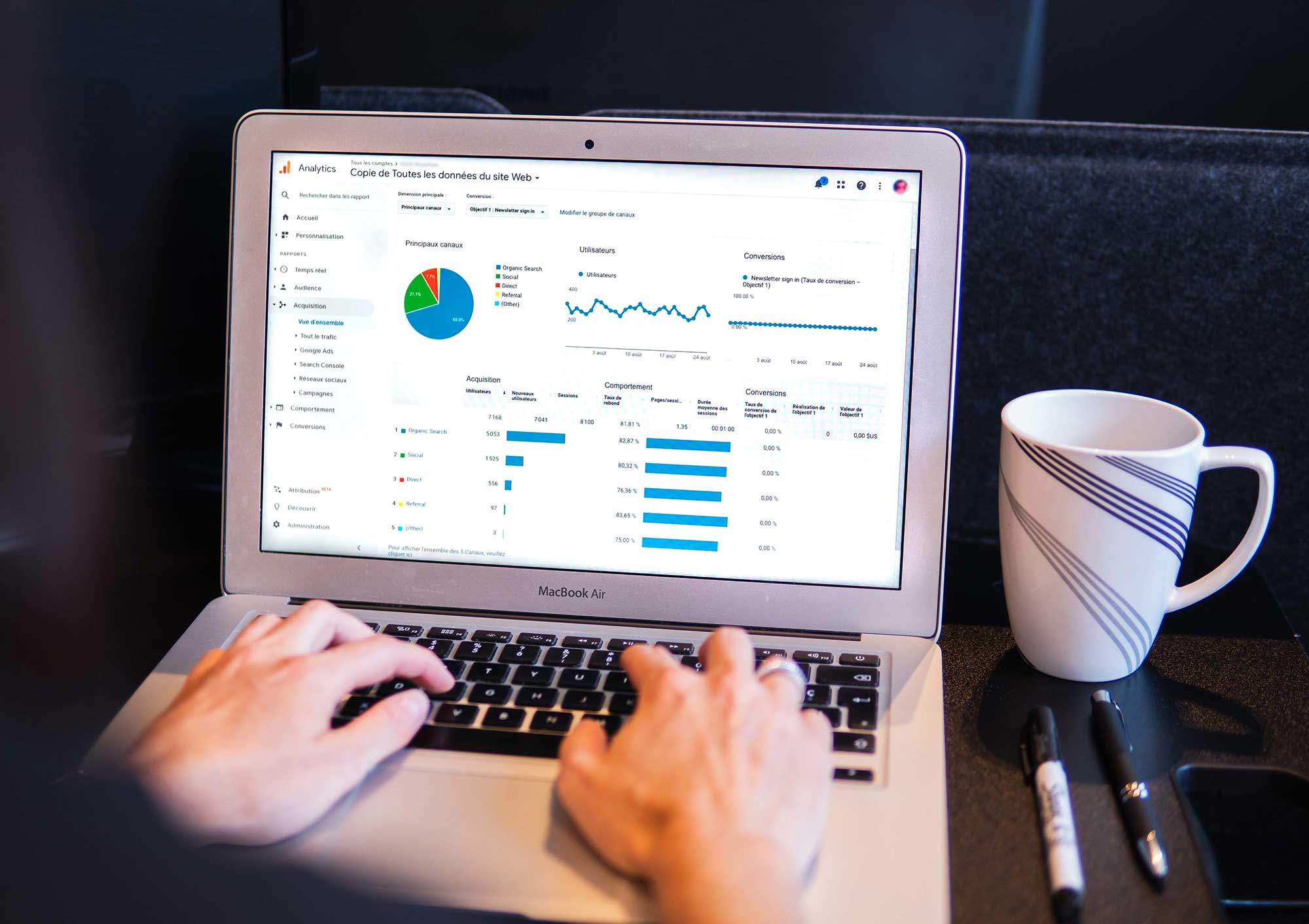Ah data. Literally the most confusing and boring part of marketing right? What do all these numbers even mean????
Unless of course, you kind of love numbers, marketing data can feel overwhelming and like a secret language. Honestly, for most of my clients, I think they might like the data part of things a little less than they like the code part of things.
Data Tells a Story
Let’s reframe data into something a lot less scary.
Data isn’t a bunch of numbers that you don’t understand – it’s literally telling the story of your success!
Unlike print and other marketing mediums, with digital we can get a lot of useful information on the demographics and actual numbers of who we reached.
Your data will literally tell you what is and isn’t working with your marketing. You have to examine the data across where you’re publishing content to see how everything is working together. Examples of where you can get useful marketing data include:
- Website
- Individual social platforms
- Email open rates
- Youtube stats
- Podcast downloads/listens
Pro Tip: Always keep track of whatever time investment you put into projects. No time is free after all!
Setting KPIs
Before you really dig into any kind of data tracking, you need to decide what you’re wanting to track! (I know, seems simple.)
One way to do that is through a KPI or Key Performance Indicator. If you’ve ever worked with a marketing agency on projects, they’ve likely thrown this term out there to talk about how they’re going to track your campaign’s progress.
KPIs are not Greek; they’re literally just a goal you want to achieve in your marketing with a date you want to hit the goal by and a measurement of success. That’s pretty much it.
KPI Example
An example of a KPI might be to grow your website visitors. Your KPI might look something like:
In order to grow leads through my website, I want to grow my monthly website visits from 100 to 300 visits this quarter by writing high-quality blog posts that I’ll share on my social media channels.
This particular KPI has a goal/relevance to your overall objective – growing website leads and visits, with a specific growth amount – increase of 100 to 300 visits, over a specific timeframe – this quarter or in the next three months, with how you plan to do that.
Choose KPIs for Your Business
When you’re first wanting to measure your success through data, I always think it’s best to practice. Pick one goal, the most important one for your business, and choose that one. Ask yourself – what’s one thing that I can do to grow my business over the next three months?
Then, break that down into a KPI with a plan! Following the example above, it can be really easy to focus on growing your email list, social media following, or something else that will influence your success.
But before you can really get a story out of your data, you have to know what you’re measuring and why, so take a few minutes to jot that out!
Measuring Website Effectives
When it comes to measuring our websites and whether not they’re working and doing what we want them to do, most digital marketers will use Google Analytics. Google Analytics is free and all it takes is installing a simple code onto your website. Whether you use SquareSpace or WordPress, they typically give you a spot to add that code pretty easily, or your website developer should have added it for you.
You need to know your goals for your website. Literally, what you want to get out of it, so that you can track whether or not its working. Sit down and create a KPI or simply take note of what you want to know. You should know the basics – how many views, where those views are coming from and on what device, and how long they spend on your website.
Own Your Data
One thing you want to keep in mind when working with an agency – make sure you have access to your own Google Analytics! There have been many times that I’ve redone a website for a client only to find out that they don’t have any control over their own data. Considering the importance of that data is to tell you exactly how well your website is working? Well, let’s just say it shouldn’t be an option for you to have full ownership of it. At the very least, your website developer can and should add you as an admin to the account so you can log in and check what’s going on.
Common Website Data Terms
When you login to Google Analytics, it can feel like a lot. Cause honestly, it is a lot! If you want to delve further into learning analytics, Google offers free, easy online courses to walk you through. However, some typical website measurements you’ll encounter are:
- Views – Literally how many views you’ve had
- Page View – How many views you’ve had on that page
- Session – A single visit to your website, consisting of one or more events, including page views, purchases, or other events.
- Channel – The source and medium your views are coming from
- Average Engagement Time – the average amount of time people spend on your website
- Bounce Rate / Engagement Rate – The percentage of people who engage on your website divided by the total number of sessions. Basically, how many people “bounce” without doing anything at all.
Understanding the basic terms will help you to know what you need to look at so you can track that. If it helps, you can create a simple spreadsheet to put your key metrics that you’re tracking into. That can be a lot less overwhelming than staring at Google Analytics all of the time and help you get a sense of your progress. However, GA provides some great breakdowns so if you can get comfortable there, do!
Privacy Laws
One thing to note, you’ve probably seen a lot of websites asking for your consent to track cookies in the last few years.
That’s because of privacy laws in the EU and California. GDPR – the EU law, and CCPA – the California Privacy Law, both require that you allow website visitors to be able to opt out of tracking. That includes Google Analytics tracking.
Talk to your web developer about installing a Cookie Consent that basically disables tracking codes if someone checks “No.” It’s actually something I do for all of my clients.
Track Social Media Success
With most social media platforms, you get access to certain analytics and data that can tell you whether or not your social media strategy is effective.
Facebook, Instagram, Twitter, TikTok, etc all come with their own in-app analytics and measurements, but using a social media scheduler like Agorapulse can actually break that down and give you a better report. If you use a scheduling app, check to see what data they can provide you because it might be easier to read than digging into all of your social media channels for that information.
What Social Media Apps “Like”
What kinds of things are you measuring on social media channels? Well, it’s similar enough to Google Analytics that if you learn that well, all other data becomes a lot easier to read. But honestly, different platforms “like” different things. However, most social media apps are going to track:
- Engagement (like/comment)
- Shares
- Video views (10 sec or full)
- Outbound clicks
A good point of reference is to understand that the more engagement your own social media gets tends to lead to more “reach” or exposure. If you have 10 people commenting on your Facebook post, Facebook is going to push that out for more people to see. Same with Instagram, TikTok, etc. Your main goal with any social media app should be to increase your engagement and go for comments over likes.
Breaking it Down – How Do I Read the Data?
So you’ve now got a basic idea of the kinds of things you can track and what they mean in their own native language.
But what the heck does all of it mean for your business????
Setting KPIs or Goals
First things first – we need to define what we’re even trying to track. That’s why we talked about KPIs upfront. Once you know what your goal is, it’s far easier for you to read the data you get and know whether or not your marketing has actually been effective for your business.
Choose a goal and decide what growth you want to see. If you already have a decent idea of what you want (i.e. more Instagram followers or increased contact forms), then you can start looking at it to get a basic benchmark of what’s already going on.
Look at How Different Channels Work Together
Another thing you have to keep in mind is that you’re following multiple channels. With Google Analytics, you might also be tracking the effectiveness of your social media campaigns because you’re looking at how many people are clicking on links from there to come to your website. You might also follow clicks from emails, actions taken after video views, or shopping cart sales.
Focus on the flow of the person through your marketing “funnels”:
- Where did they come in from?
- What did they do once they got on my website?
- What did they sign up for?
- What is generating sales/revenue?
- Don’t be afraid to find out your instincts are wrong
One thing to keep in mind though – not everything is going to be as easily trackable. You may have to dig a bit through a couple of different platforms to get a good idea of what your audience is doing and how they’re interacting with your contact. And what part of your marketing is working effectively.
What Do You Feel in Your Business
The best indicator to know what’s working and what’s not though – what’s working in your business. Are you getting increased sales for the pieces that you’re trying to increase? Are you seeing the results that you’re looking for?
Your analytics and data can certainly tell you a story of how your marketing is performing, but the only thing that really matters is if you’re getting the results you want to get.



